Napoleon desperately wanted this battle, so, at 6am on the morning of the 5th of August, although outnumbered, 21,500 French against 25,000 Austrians, he began the battle.
Wurmser's headquarters were at Solferino, and had he drawn his forces up with his right positioned on the Solferino Heights which contained a castle and tower.
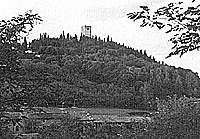 Note: it appears that GM (General Major) Mittrowsky's Brigade, containing possibly three battalions of the KK IR4 Deutschmeister Regiment, was part of the Austrian defence of these heights near the Rocca Tower--also known as Tower of Spia d'Italia. Photo at right shows it as viewed from Austrian 1st Line position. Photo at left shows detail.
Note: it appears that GM (General Major) Mittrowsky's Brigade, containing possibly three battalions of the KK IR4 Deutschmeister Regiment, was part of the Austrian defence of these heights near the Rocca Tower--also known as Tower of Spia d'Italia. Photo at right shows it as viewed from Austrian 1st Line position. Photo at left shows detail.
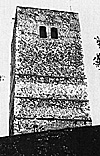 Wurmser anchored his left flank on a hill called Monte Medolano, where an artillery redoubt, containing most of his heavy guns and at least two battalions of infantry, was placed. Considering the lack of time and the fact that both sides were still generally exhausted from marching and fighting and from the intense heat of the day, the redoubt was probably a rough affair. If anything, I should imagine it consisted mainly of earthworks. Between these two strong points, on the plain of Castiglione, in two parallel lines, was positioned the rest of the Austrian army. Most of the cavalry was placed to the rear of Monte Medolano.
Wurmser anchored his left flank on a hill called Monte Medolano, where an artillery redoubt, containing most of his heavy guns and at least two battalions of infantry, was placed. Considering the lack of time and the fact that both sides were still generally exhausted from marching and fighting and from the intense heat of the day, the redoubt was probably a rough affair. If anything, I should imagine it consisted mainly of earthworks. Between these two strong points, on the plain of Castiglione, in two parallel lines, was positioned the rest of the Austrian army. Most of the cavalry was placed to the rear of Monte Medolano.
Napoleon's plan was to draw the Austrians forward out of their strong positions until Fiorella arrived and attacked the Austrian's left flank in the rear. Fiorella would be supported by Dragoons at present successfully screening his advance from the Austrians. In the chaos caused he would then storm Monte Medolano and break the Austrian lines in two.
This of course required careful timing and relied heavily on things going to plan. He ordered Massena (now down to around 6,000 men) to attack the Austrian right, and Augereau (now up to around 11,500 men) to storm the left and centre. General Beaumont (taking over from a sick Kilmaine) with the cavalry would hold the far right of the French lines. Three battalions of grenadiers, and all the Horse artillery (18 guns) was placed on the right flank ready to storm the redoubt. (See MAP 2)
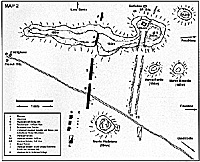
Large Map 2 (slow: 110K)
Jumbo Map 2 (slow: 246K)
At first the plan seemed to be working. Not long after the fighting started, Massena and Augereau began to pull back their units. The Austrians, to Napoleon's relief, started to leave their positions and to advance after them. Wurmser ordered his right flank, possibly his strongest side, to advance from their positions on the Solferino heights and try to outflank Massena's forces. The fact that Wurmser could believe so easily that the French were retreating may lie in what he found at Mantua. It's not clear if Wurmser actually went to Mantua himself or relied on a report from one of his officers, but the passage below from THE FRENCH IN ITALY by Angus Heriot, may well hold the answer as to why Wurmser ordered an advance so readily and at such an early stage of the battle.
- 'In fact, the besiegers had hurriedly abandoned their position, leaving behind them masses of equipment, and the Austrian general "found the trenches and batteries entire, the guns overturned and spiked; the whole place covered with the wreck of carriages, platforms, and ammunition of all kinds. The precipitation with which these measures seemed to have been effected probably gave him great satisfaction; for everything he saw around him seemed much more like the effect of terror than the result of a calculated plan."'
With this in his mind, and the wretched state of the French army, not that Wurmser' s army was all that much better, may well have convinced him that they were indeed retreating. But of course, as with other Austrian Commanders, he didn't account for the calculating mind of Napoleon; the mind of a gambler willing to take risks.
Later in the morning, to the complete surprise of Wurmser, Fiorella arrived. The French screening cavalry had done their job well. His arrival now gave Napoleon slight numerical superiority for the first time, the French now numbered around 27,000 men, and he immediately ordered Massena and Augereau to turn and attack the advancing Austrians, to pin them down while Fiorella moved into position to attack.
However, Fiorella attacked too early before the French could pin them and Wurmser had time to deploy his 2nd line to face this new threat to his left flank. The failure of the French to pin down the Austrians cannot be blamed totally on Fiorella. The French soldiers had been marching, counter-marching and fighting for several days and were close to exhaustion so they were probably much slower in their manoeuvres. Some were also confused by being ordered to withdraw and then attack. Indeed, Napoleon himself had to personally urge some units into action again.
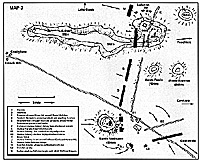 The Austrians, due to the confusion, were able to fall back to their original positions on the Solferino Heights, with the second line moving to face Fiorella. Wurmser's army now formed a reversed L-shape with the redoubt on Monte Medolano acting as a hinge and centre of the Austrian line.
The Austrians, due to the confusion, were able to fall back to their original positions on the Solferino Heights, with the second line moving to face Fiorella. Wurmser's army now formed a reversed L-shape with the redoubt on Monte Medolano acting as a hinge and centre of the Austrian line.
Large Map 3 (slow: 115K)
Jumbo Map 3 (slow: 269K)
Napoleon decided it was now time to attack the hinge. He ordered Chef De Bataillon Auguste Marmont, under the protection of the cavalry, to bring up his 18 guns. This Marmont did, and from close range and under fire from the heavier calibre guns, the horse artillery bombarded the fortified position. The French guns were 4 pdrs and the Austrian guns may have been 6 and 12 pdrs, and possibly some French 8 pdrs captured at Mantua.
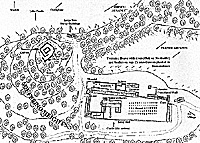 This bombardment was followed up by the three grenadier battalions, commanded by Verdier, attacking with the bayonet and the redoubt was taken. Beaumont led a brigade of cavalry around Monte Medolano to link up with Fiorella and Marmont followed with his guns. (See MAP 3)
This bombardment was followed up by the three grenadier battalions, commanded by Verdier, attacking with the bayonet and the redoubt was taken. Beaumont led a brigade of cavalry around Monte Medolano to link up with Fiorella and Marmont followed with his guns. (See MAP 3)
Although the Austrian left now began to fall back in confusion, they were tough units and the breakthrough wasn't complete. At this point, Adjutant General Leclerc with the 4th and 5th Demi-Brigades, arrived and formed up on Massena's left. These pushed Napoleon's army up to around 32,000 men and he ordered all attacks along the line to be pushed vigorously. Leclerc stormed Solferino Castle and captured the surrounding heights. Wurmser himself was almost captured but escaped by a whisker. Not surprisingly he ordered a general retreat back towards Peschiera. They left behind 2,000 dead, at least 20 cannons and 1,000 prisoners.
Wurmser, although 80 years old, courageously covered the retreat by personally heading repeated cavalry charges. GM Mittrowsky and GM Schubirz and a battalion of the IR4 Deutschmeister Regiment, also covered the retreat until they were aided by fresh troops from Peschiera. These being Commanded by Bajalich with at least 3 or 4 battalions commanded by Colonel Weidenfeld. (Note that their arrival, had the Austrians been able to hold onto their positions, would have pushed their numbers up to 30,000, almost equal to the French). They attacked Massena's men in the flank and stopped their pursuit.
This enabled the Austrians to carry out their retreat towards the River Mincio in relatively good order. Some units passed through Cavriana and crossed at Borghetto, while others crossed at Peschiera.
Although the French, even on the following day were still too tired and exhausted to pursue effectively (it must be noted that the heat of the month would have had a great sapping effect on both sides) they managed to force Wurmser, who was now holding a line from Roverbella to Peschiera, to retreat once more.
So, in conclusion, we can say that, on the one hand Napoleon had won the day and defeated the first Austrian attempt to relieve Mantua and so remained in control of Northern Italy. But on the other, Wurmser had managed to re-supply the fortress with fresh men and supplies, and the tough fighting of his troops had given the French a good run for their money. And, although the Austrian Army had been forced to limp away, it lived to fight another day. On the 7th the French captured Verona and Wurmser headed his defeated army North. On the 24th of August, Mantua was again under siege.
Overall, Wurmser's first attempt to relieve the fortress; a series of minor engagements and the Battle of Castiglione, had cost the French a total of around 6,000 men and 4,000 prisoners, but the Austrians had suffered far worse with a loss of around 17,000 men.
More Castiglione
More in the Series
Back to Table of Contents -- First Empire #23
Back to First Empire List of Issues
Back to MagWeb Master Magazine List
© Copyright 1995 by First Empire.
This article appears in MagWeb (Magazine Web) on the Internet World Wide Web. Other military history articles and gaming articles are available at http://www.magweb.com